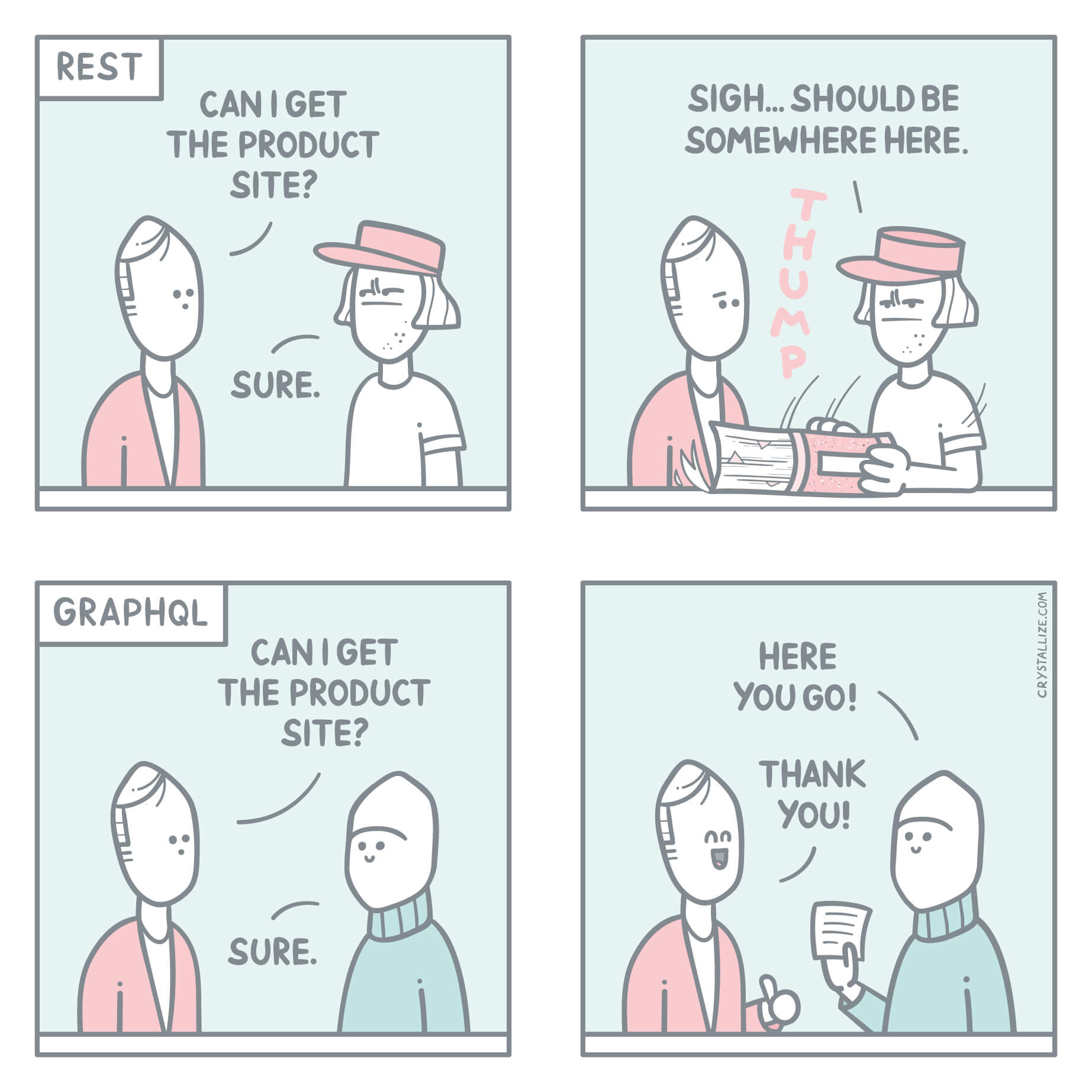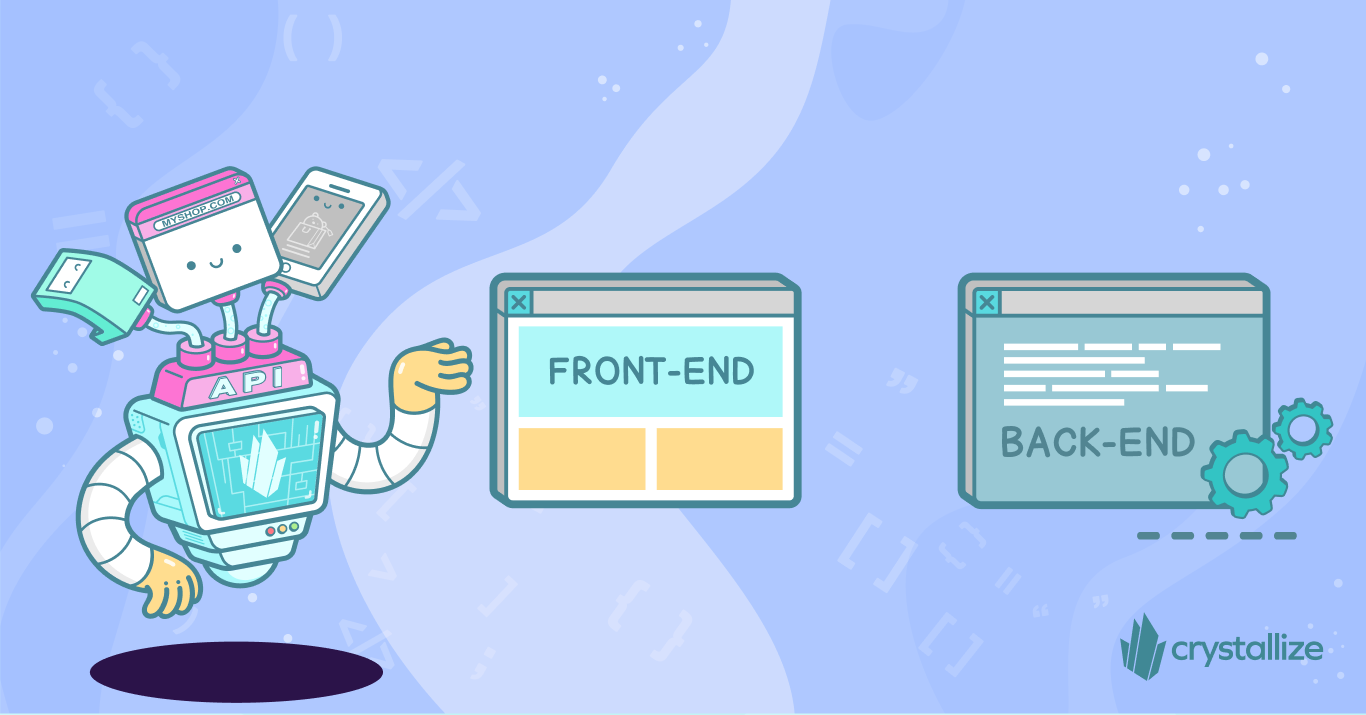Maximizing PIM Efficiency with GraphQL APIs
Product catalogs are rapidly expanding, and customer expectations for seamless, dynamic experiences are sky-high, making efficient Product Information Management (PIM) a necessity rather than a nice-to-have feature.

Traditional approaches, reliant on REST APIs, can often be sluggish and inefficient, particularly when dealing with vast amounts of data. That’s where GraphQL steps in to revolutionize the game.
GraphQL APIs provide precision and efficiency that can be transformative for PIM systems because they minimize data transfer, speed up page loads, and reduce server strain by allowing you to query exactly what you need, nothing more.
This isn't just a technical win; it's a business advantage that delivers faster load times, leading to better SEO, more traffic, lower bounce rates, and, ultimately, more conversions.
Let’s explore the distinct advantages of using GraphQL over traditional REST APIs in PIM, dive into Crystallize as a case study, and highlight how GraphQL is shaping the future of PIM. From reducing latency to enabling personalized, omnichannel experiences, we'll cover how GraphQL APIs transform the developer experience and business outcomes.
Buckle up because the future of PIM is faster, smarter, and more flexible than ever before.
GraphQL APIs in PIM Platforms
GraphQL isn’t just about fetching data faster. It’s about giving developers, marketers, and business owners the tools to innovate without the constraints of a rigid backend. When implemented in PIM solutions (like Crystallize), GraphQL APIs enable businesses to manage product data with surgical precision in real-time.
Let’s break down some key features that make GraphQL the superhero of APIs in PIM.
Tailored Queries: Only What You Need
Traditional APIs are like bulk shopping; you must take everything, whether you need it or not. GraphQL lets you query precisely what you want. If you need just the product title and price, that’s all you get. No extra metadata weighing down your response. This is particularly useful when rendering data-heavy pages where you only need specific parts of product information.
Imagine this: you want to render a page with 100 products, each with multiple images, prices, descriptions, and upsell recommendations. With REST, that means 100 (or more!) separate API calls, each fetching one chunk of data at a time. If you're running a high-performance front end, you know that those milliseconds add up. Latency is the enemy of user experience and, ultimately, revenue.
With GraphQL, you can pull in all the data you need — from the same 100 products to their images, prices, and recommendations — in just one call. No more pinging the backend repeatedly like it owes you something.
👇Source: Rest vs GraphQL: Part II Crystallize WebDev Comics.

Reduced Payload Sizes
Payload sizes are naturally smaller because you control how much data comes back. That translates into faster load times, crucial for mobile-first businesses and SEO. If your catalog has thousands of products, even a slight reduction in the payload can save serious bandwidth and improve your overall site performance and user experience.
For example, you can fetch only the image sizes you need instead of going for a full batch, making your payload much smaller.
Real-Time Updates for Dynamic Content
In a fast-moving eCommerce landscape, product data needs to be flexible. For example, prices, inventory, or descriptions change constantly. With GraphQL-powered PIM systems like Crystallize, you can instantly reflect these changes across all your sales channels. There is no caching and no delays. The data you see is always live and fresh.
Seamless Integration with Frontend Frameworks
GraphQL plays well with modern frontend frameworks like React, Vue.js, Astro, Next.js, Remix, etc. These integrations mean faster time-to-market for new features, enhanced SEO, and lightning-fast user experiences. Developers can build fully customized frontends without reworking the entire backend, a dream scenario for both tech and business teams.
Simplified Maintenance and Scalability
With a single API endpoint, maintenance becomes a breeze. You don’t need to manage multiple versions of the API, unlike REST, where changes often require versioning to avoid breaking existing functionality. For businesses, this means fewer resources spent on keeping the tech running and more on growth.
Why This Matters for Business Development?
For business leaders, GraphQL's flexibility in PIM platforms like Crystallize goes beyond the technical. It means faster iteration on new product launches, seamless omnichannel strategies, and an enhanced customer experience that scales as your business grows.
GraphQL isn't just a buzzword — it's an opportunity for innovation and efficiency that can directly impact your bottom.
Crystallize Case Study: A Headless PIM with GraphQL
Instead of building a better PIM, CMS, eCommerce, or order management service, we wanted to design an API layer you need to market and sell your products on any channel, at any scale, and in any way you want.
If you’ve ever worked with Crystallize’s GraphQL API, you already know how seamless it is to pull in exactly what you need from their catalog. Whether you’re working with product data, documents, images, or orders, it’s all structured and delivered in real-time - no lag, no waiting.
Crystallize’s approach to headless PIM is unique. It combines product information management with rich media management (think images, videos, and marketing content) — all handled through a single GraphQL endpoint. This means you can tailor your frontend experience without worrying about the backend bogging you down.
Key Components of Crystallize’s GraphQL PIM
- Catalogue API allows you to retrieve and manage all catalog data—from folders to individual products and their variants—using one powerful GraphQL query. This is where the magic happens for scaling massive product collections.
- Do you need to do deep searches across your product catalog? The GraphQL-powered search API lets you pull out highly specific data, whether filtering by product type, price, availability, or custom attributes.
- Order & Subscription APIs manage the customer-facing side of things. Whether dealing with order intake or recurring subscriptions, you can do it all with minimal hassle. And because it’s GraphQL, you’re querying only what you need, saving processing time and reducing server strain.
What’s innovative here is how quickly you can adapt to business needs. The flexibility to query only necessary data means frontend changes or scaling your catalog don’t come with the usual backend headaches. You build and deploy what you want across multiple platforms—web, mobile, app, or even in-store kiosks—from the same core product catalog.
For developers, this is the dream: APIs that can manage product data, images, marketing content, and even customer transactions. For business leaders, the reduced latency and improved user experiences translate directly into better conversion rates.
Enhancing SEO and UX with GraphQL in PIM
SEO and user experience aren’t just fancy designs or keyword optimization anymore. They’re about speed, accuracy, and user interaction — all things GraphQL excels at. In eCommerce, particularly when dealing with large product catalogs, these factors are make-or-break for conversions.
Fast Page Load Times = Better SEO
Let’s get straight to the point: speed is crucial. Google’s algorithms love fast-loading sites. That’s not just a developer’s problem; it’s a business problem. When a page loads slowly, customers leave, bounce rates increase, and your SEO ranking takes a hit. With REST APIs, the constant back-and-forth between server and client can slow load times, especially for complex product pages.
GraphQL turns this around by enabling your front end to pull in only the needed data. Instead of wasting bandwidth on unnecessary information, you get hyper-specific queries that load pages faster, improving SEO and customer satisfaction.
For example, if you’re building a product landing page, you can query just the product name, images, price, and availability in one go without excess baggage.
Enhanced User Experience with Dynamic Content
Your customers expect fast, personalized experiences. With GraphQL, you can tailor those experiences by dynamically loading product information, personalized recommendations, or even real-time inventory updates. The ability to load precisely what the user needs at any given time (without overloading the server) gives your site a snappy, responsive feel.
Crystallize’s headless PIM lets you take this even further. By integrating your product catalog with rich media content — all served via the same GraphQL API — you ensure that customers see relevant product videos, detailed images, and descriptions instantly. This not only enhances user engagement but also boosts conversion rates. And let’s not forget happy users are more likely to return and share your site.
Multichannel and Omnichannel Flexibility
With more businesses embracing omnichannel strategies, having a flexible PIM system is essential. GraphQL APIs allow you to power everything from your main website to mobile apps, social media storefronts, and even offline kiosks, all from the same product data repository. You can repurpose your content across multiple touchpoints while ensuring consistency in your product information.
GraphQL also makes adding or removing channels easy without reconfiguring your entire backend. This is a win for business agility. Want to introduce a mobile app for your product catalog? With GraphQL, it’s a simple adjustment in your query, and no backend overhaul is required.
In short, GraphQL doesn’t just make your PIM more efficient — it makes your entire user experience better, from the first click to the final checkout. And that’s where the real ROI kicks in.
Future Trends in GraphQL-Powered PIM Systems
The future of GraphQL-powered PIM systems is poised to drive the next wave of innovation in eCommerce and product data management. As businesses grow and the digital landscape becomes increasingly complex, it’s clear that traditional methods of managing product data are no longer sufficient.
Edge Computing and Real-Time Data Delivery
As more businesses adopt edge computing, there’s a growing demand for PIM systems that can deliver data closer to the user, reducing latency and ensuring faster, more reliable access to product information. With GraphQL APIs, this trend perfectly aligns with the ability to fetch real-time, localized data from distributed servers.
We’ve already said that the future of PIM is on edge. Edge computing allows product data and media to be processed at data centers physically closer to the customer. This reduces the time it takes to deliver personalized, dynamic content such as product recommendations, real-time pricing, or inventory updates.
AI and Machine Learning Integration
By leveraging GraphQL’s flexible querying capabilities, PIM systems can enable AI-driven product recommendations, automated tagging, dynamic content personalization, and AI-powered translation. The future with AI is already here, and a lot more can be done.
For example, suppose an AI model detects a customer frequently browsing specific product categories. In that case, it can trigger a GraphQL query to load personalized recommendations for that category across all touchpoints. AI can also assist in optimizing backend processes, such as predictive inventory management, all connected seamlessly through GraphQL APIs.
API-First and Microservices Architecture
As the eCommerce world shifts toward API-first and microservices architecture, GraphQL-powered PIM platforms are leading the charge. Businesses are moving away from monolithic platforms in favor of lightweight, decoupled services that allow greater flexibility and scalability.
The need for agility drives this trend. We see clients wanting to pivot quickly, launch new products or features, and experiment with different platforms (web, mobile, aoo, POC, IoT, etc.). Microservices' modularity, combined with GraphQL’s ability to consolidate multiple data sources into a single query, means companies can innovate faster and scale more quickly.
Expanding Beyond Traditional Commerce
As the digital commerce ecosystem continues to evolve, so will the scope of GraphQL-powered PIM solutions. We already see PIMs used in non-traditional commerce sectors like IoT, 3D product configurators, augmented reality (AR), and virtual reality (VR). These emerging platforms require real-time, structured data delivered seamlessly across multiple devices, and GraphQL fits the bill perfectly.
For instance, imagine a retail store where customers use AR to visualize products in their home environment. The product data—variants, dimensions, pricing, and availability—must be fetched in real-time from a PIM. GraphQL APIs will make it possible to query only the relevant information for that particular AR experience, optimizing performance and data usage.
Check how you can create stunning 3D product configurators with AR with Blender for 3D modeling and Crystallize on the backend for product data.
Improved Developer and Business Collaboration
One of GraphQL's key strengths is its ability to bridge the gap between developers and business teams. Because of its self-describing nature and ease of use, non-technical stakeholders can collaborate more effectively with development teams. This trend will continue, with more businesses leveraging GraphQL’s schema-based API documentation to empower business users to explore data, run queries, and understand how the system works without needing deep technical knowledge.
As more businesses adopt GraphQL, the developer experience will improve, leading to more efficient workflows, faster onboarding for new team members, and reduced reliance on extensive documentation. The result? Businesses can be more responsive to market demands, rapidly iterating on their product offerings and enhancing customer experiences.
A Future Built on Flexibility and Speed
Businesses that adopt GraphQL for their product management will be well-positioned to capitalize on these trends, delivering faster, more personalized experiences while maintaining the agility needed to stay competitive in an increasingly complex digital landscape.
Whether you're scaling your product catalog, optimizing SEO, or diving into new customer engagement channels, the combination of GraphQL and PIM will be a core driver of future success.
Crystallize powers product information management for some of the world's largest companies. Let us show you how our engine can help your business grow.
CLICK HERE and set up a personal 1-on-1 Crystallize demo. Let’s discuss your use case and take it from there.
Alternatively, why not SIGN UP for FREE, try Crystallize, and get our team's unparalleled support to help you get going.
Future Reading
Dive deeper into the subject with the following:
Mastering the Art of API Design - https://dev.to/ndulue/how-to-optimize-graphql-queries-for-better-performance-30e
How to optimize GraphQL queries for Better performance - https://blog.bytebytego.com/p/api-design
Optimized GraphQL data fetching strategies - https://allthingsopen.org/articles/optimized-graphql-data-fetching-strategies
GraphQL Optimization: Unleashing the Power of Efficient Data Queries - https://mobilelive.medium.com/graphql-optimization-unleashing-the-power-of-efficient-data-queries-f67cad622509
Follow the Rabbit🐰

GraphQL for eCommerce: Benefits, Use Cases, and Best Practices
Why the buzz? Well, GraphQL is changing the game for e-commerce, allowing stores and apps to communicate with backends more efficiently. It reduces excessive data retrieval, making sites run faster, and helping them adapt quickly to new ways of reaching customers.

The Future of PIM is on the Edge
Edge computing makes it possible to deliver and process data even closer to end-users today, and businesses are slowly discovering the potential it offers.

Understanding Product Information Management (PIM) Done Headless
A headless approach to PIM means having a service ready to manage product information in seconds. Product information and content are delivered via an API. There are no templates, no web pages, only structured content—pure developer bliss.

